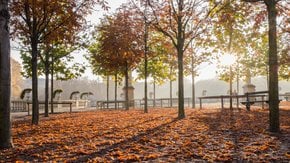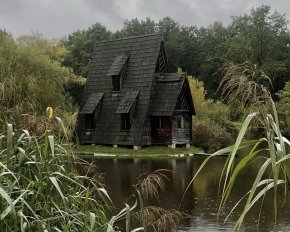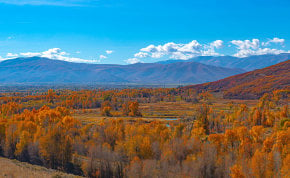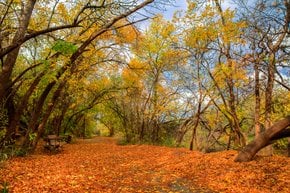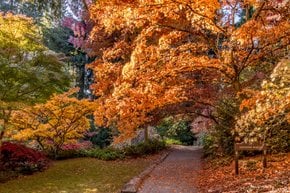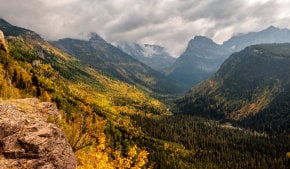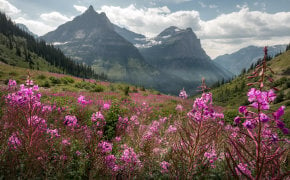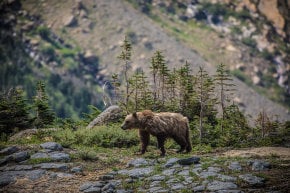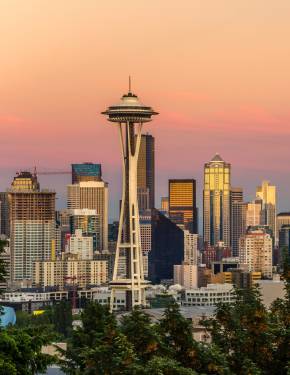Fall Colors in Glacier National Park, MT 2026
Autumn paints Glacier Country in golden hues
Best time: mid-September–late October
Fall is one of the best times to visit Glacier National Park. Crowds get thinner, wildlife is easier to spot, and beautiful fall foliage blankets the valleys and hills. Glacier National Park boasts a particularly rich fall color palette due to quite a wide variety of tree species. Aspens and cottonwoods paint the landscapes in bright yellow and warm orange. Western larch is especially impressive with its amber-colored needles. Birch adds even more golden tones. Rocky Mountain maple contributes with some red to complete the picture. Fall weather in Glacier National Park is perfect for such activities as hiking, kayaking, boating, and cycling.
Best time for fall colors in Glacier National Park
The beautiful transformation in Glacier National Park starts in September when aspens turn yellow. The fall first arrives at the western part of the park, where spectacular foliage displays can be already viewed in mid-September. The eastern part of the park gets golden and bronze tones by the end of September. Some of the brightest fall displays can be viewed at higher elevations, where western larch trees are especially abundant. They grow on all mountains on the west side of the park. Western larch (Larix occidentalis) begins changing only in mid-October, dropping its needles by the end of the month. At this time you can capture changing trees with the stunning snow-capped peaks in the background. Generally, the best time for leaf peeping in Glacier National Park runs from mid-September to late October. Also, keep in mind that some trails and park facilities close in late September, so plan your trip accordingly.
West Glacier
The west side of Glacier National Park is famous for its old-growth forests with plenty of evergreens, which make the yellow highlights of the deciduous trees even brighter. Visit the shores of Lake McDonald for the fieriest display or head to Essex for some river views. If you are up for a real hiking challenge, take the South Boundary Trail, which starts in West Glacier and runs along the Middle Fork Flathead. The 11.5-mi (18.5-km) trail takes about five hours to complete. The route features a river crossing, John F. Stevens Canyon, and spectacular views of a young forest, which has regrown after the 1920s fire. Another idea is to take a scenic rafting trip along the Middle Fork of Flathead River. The waters are calmer in the fall, so it's a perfect occasion for a leisurely float.
North Fork
North Fork of the Flathead River boasts many aspens that show off golden hues quite early in the season. At higher elevations, larch trees turn yellow in mid-October. Bowman Lake is perhaps the most scenic destination in the area. The long and narrow lake is surrounded by a lush forest, which looks simply stunning in the fall. Unpaved North Fork Road suits well for fall foliage viewing biking trips.
East Glacier
Two Medicine Valley and St. Mary are the best leaf-peeping destinations in the eastern part of the park. Take a scenic hike to Lower Two Medicine Lake to photograph some beautiful reflections. This area is part of the Blackfeet Indian Reservation and has been considered sacred for centuries.
Scenic Point Trail, which starts near East Glacier, initially travels through the beautiful forest, then passes Appistoki Falls and Appistoki Creek, ending at the Scenic Point Summit, which provides panoramic views of the Two Medicine Valley peaks. The 7.7-mi (12.4-km) trail was created by the Great Northern Railway to connect the Glacier Park Lodge and the Two Medicine Chalets in 1913. Part of the route goes along Mt. Henry Trail leading to Mount Henry (8,847 feet or 2,696 m).
Scenic Drives
Going-to-the-Sun Road
Fifty-mile-long Going-to-the-Sun Road traversing the Continental Divide is a must-see in the fall. Mind that only portions of this road will remain open from mid-October. The best time to take a drive is during the last two weeks of September. The west side of the road up to Logan Pass is especially scenic due to panoramic views of the valley. The Loop stuns with aspens bursting in color. When you finally get to St. Mary on the east side, there are more spectacular trees to see.
Many Glacier Road
Many Glacier Road stretches for 12 miles (19 km) from Highway 89 to beautiful Swiftcurrent Lake. The road is lined up with trees and looks amazing in the autumn. Further north, you can take a ride on the Chief Mountain International Highway to view stunning yellow aspens.
Highway 2 and Highway 49
Travel on Highway 2 from West Glacier to East Glacier and further to Browning going through beautiful forested terrain. From East Glacier, you can also take Looking Glass Highway or Highway 49 which goes along the southeastern part of the park offering great views of the Two Medicine Valley, Cut Bank Area, and much more. Plenty of aspens and cottonwoods make it a great spot for a drive in late September.
Glacier National Park is still an underrated fall destination, and hence there are much fewer cars and people here during the fall foliage season than in more popular leaf-peeping destinations. So don't wait too long to plan your fall adventure. The views of the Glacier Country wrapped in golden hues will surely blow your mind!










